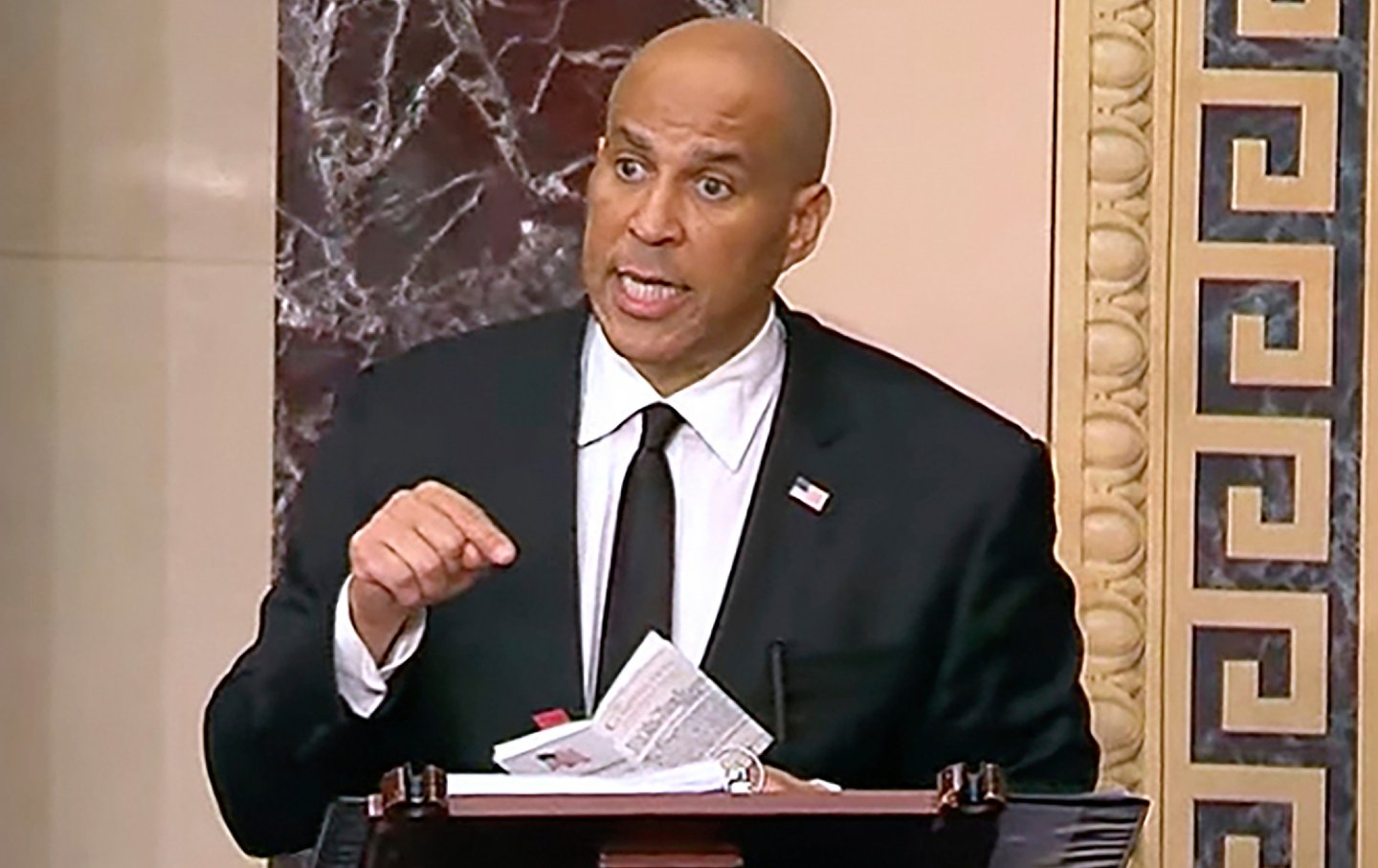Is There Any Chance That Congress Can Be a Check on Trump?
Republicans grabbed the Senate, but Democrats could still take the House—and no matter what happens, they have a duty to fight Trump with everything they have.

Hakeem Jeffries and Mike Johnson during a ceremony in Emancipation Hall at the US Capitol in Washington, DC, on Tuesday, September 24, 2024.
(Al Drago / Bloomberg via Getty Images)When people asked me in the final weeks before the 2024 election about where I thought things were headed, I often suggested that the contest would likely resemble one of two past contests. One option was a result like that of Barack Obama’s win in 2012, where Democrats, as an incumbent party, kept the White House by a narrower, though still comfortable, margin and held the Senate, yet failed to take the House. The other option was a more daunting one: that of Ronald Reagan’s win in 1980, where Republicans challenged a Democratic incumbent, won the White House decisively, and took the Senate, yet failed to take the House.
We got the Reagan option, only worse. This year, Americans saw what civil rights lawyer Connie Rice describes as “a decisive dark red wave that drowned the better angels of progress.” It isn’t just that Donald Trump is so much more dangerously inclined than Reagan who, though he was the iconic conservative figure of the mid-20th century, would have a hard time finding a place in Trump’s GOP. It’s also that today’s Republican Party is actually much more closely aligned with Trump—in some cases out of actual agreement, in other cases out of fear of Trump’s penchant for retribution—than it ever was with Reagan in the 1980s. Trump will, in all probability, use the power of the presidency more aggressively and recklessly than his predecessors did.
But just because the task is going to be difficult doesn’t mean Democrats can throw in the towel. They have to find ways to check and balance this president. And, for this fight, history is instructive.
Some of the congressional dynamics in the coming months and years could be similar to the Reagan era. In the 1980s, Democrats and their allies in the labor, environmental, and civil rights movements initially built bipartisan congressional coalitions to upend some of the 40th president’s most cherished initiatives. Eventually, they figured out how to regain control of the Senate and expand their House majority. Recognizing the prospect that history can repeat is vitally significant for the organizing of an effective opposition to the second Trump presidency.
It’s also important to recognize that we do not know precisely how the 2024 race has ended.
Because key races for the House and Senate remain undecided, a lot about this election is still up for grabs. With millions of ballots yet to be counted—mostly in the heavily Democratic states of California, Washington, and Oregon—we don’t even know what the final popular vote count will be.
But here’s some of what we know as of Thursday morning.
THE SENATE: With the defeat of Democratic incumbents Jon Tester of Montana and Sherrod Brown of Ohio, as well as the flipping of a historically Democratic seat in West Virginia, the Republicans now have at least a 52–48 majority in the Senate. That GOP majority could expand, as Democratic incumbents are trailing in two additional states. Republicans could end up with a 53-47 majority, perhaps even 54–46.
The size of that majority matters. If it is narrower, then appeals to Republicans who have distanced themselves from Trump at crucial moments in the past, such as Alaska’s Lisa Murkowski and Maine’s Susan Collins, as well as a handful of other GOP senators who have broken with Trump on individual issues, could yet block the new president’s most noxious cabinet picks and initiatives.
During Trump’s first term, teachers unions and their allies in Alaska and Maine convinced Murkowski and Collins to oppose Trump’s selection of billionaire Betsy DeVos to serve as secretary of education. Murkowski and Collins, urged on by activists with groups such as MoveOn, joined Arizona Senator John McCain in voting to save the Affordable Care Act.
If the Republican majority is wider, it will be harder to move the Senate. But labor, environmental, education, civil rights and civil liberties activists in the states could find openings—not just with Murkowski and Collins but also with the 20 Republicans who will be up for reelection in 2026 (as opposed to 13 Democrats).
THE HOUSE: Control of the House is still up for grabs, and, since this fight will determine whether Democrats maintain any legislative control in Washington, how it turns out is vitally important. As I write, several dozen races are yet to be called. Republicans have the advantage. But a substantial number of the undecided seats are on the West Coast—in California, Washington, and Oregon. There is still a remote possibility that New York Democrat Hakeem Jeffries could emerge as the speaker of the House. If that happens, however, his majority would be minuscule and his challenges great. His first responsibility would be to avoid the frequent mistake of Democrats who greet a new Republican administration with simplistic pledges to seek avenues of cooperation. If Trump does something positive, of course Democrats can work with him. But if he moves in the wrong direction, as he has promised to do, House Democrats have to use every tool at their disposal to check and balance Trump. And they should be clear about their willingness to do so on behalf of an American electorate that, according to CNN exit polling, believes by a 55 percent majority that Trump is “too extreme.”
Whether they are narrowly in the majority or narrowly in opposition, this is the time for congressional Democrats to show some spine. They need to be courageous on issues where too many of them have been cautious—including defenses of vulnerable and threatened communities, dramatically raising the minimum wage, expanding labor rights, rejecting tax cuts for the rich, strengthening Social Security, Medicare, Medicaid, and the Affordable Care Act, and opposing the horrific Israeli assault on Gaza.
Firm lines in the sand need to be drawn early and maintained. There have to be positions that are nonnegotiable. If there are not, Trump will take full advantage of the openings that Democrats hand him.
Activists inside and outside of the Democratic Party need to remind elected leaders of this fact.
As frustrated, angry, and overwhelmed as they may be by Tuesday’s election results, those who want to fight back against Trump and Trumpism must remember that they have power of their own. They can use it to make clear to the leadership of the Democratic caucuses in the House and the Senate that, just as Trump will claim a personal mandate, they must claim a constitutional mandate to check and balance Trump’s excesses. It is not enough for those who oppose Trump’s policies to lobby congressional Republicans to do the right thing on a particular issue, even if such lobbying is important. It is just as essential to pressure Democrats to stand strong on behalf of the constituencies they are supposed to represent.
Popular
“swipe left below to view more authors”Swipe →THE STATES: Democrats currently serve as the governors of 23 states and three territories. In a number of those states, from New York to California, the party also controls the legislature as well. These states need to establish themselves as beachheads against Trump’s worst excesses. There will be specific fights between the new administration and state officials on issues ranging from immigration to the climate crisis to abortion rights, raising wages and education—issues on which, in a number of cases, referendums results from red and blue states suggest that the American people are far more progressive than the leaders of either party recognize.
Smart strategies, education, and organizing are going to be needed at every level of campaigning and governing. It won’t be easy. There will be defeats. But there will also be victories; there always are, even in the darkest times. The task is to organize toward a politics where there are fewer losses and more wins for the priorities that matter most to Americans.“What do we do?” asks Representative Greg Casar, a progressive Democrat from Austin, Texas, who called for a Gaza ceasefire, took bold stances in favor of economic, social, and racial justice, and on Tuesday won reelection with 67 percent of the vote. Casar answers: “We organize, care for each other, and fight back through the fear and anger. We build a new Democratic Party that is for ALL working people, unafraid to confront billionaires and corporate greed. We defeat Trump and Trumpism—not in one election, but with one movement.”








